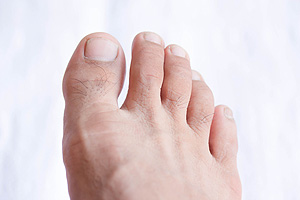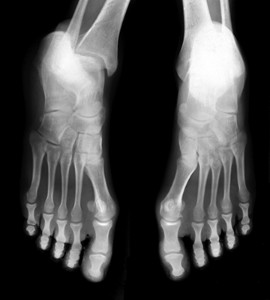 Arthritis can affect a person in many different ways. One form of inflammatory arthritis is known as gout, which may often cause issues for the toes, specifically the big toe. Gout typically develops due to a buildup of uric acid when the body tries to break down purines found in foods. Dietary changes may be effective in reducing purine levels as well as the likelihood of a gout flare up. Drinking a lot of water may help with the swelling and inflammation that is often caused by gout. Another method of reducing gout-related inflammation, is by icing the affected joints and keeping the feet elevated. As far as reducing your purine levels, it’s advised that you avoid meats and fish such as bacon, turkey, scallops, and muscles, to name a few. For more advice on how to manage your gout, we recommend that you consult with a podiatrist for professional care.
Arthritis can affect a person in many different ways. One form of inflammatory arthritis is known as gout, which may often cause issues for the toes, specifically the big toe. Gout typically develops due to a buildup of uric acid when the body tries to break down purines found in foods. Dietary changes may be effective in reducing purine levels as well as the likelihood of a gout flare up. Drinking a lot of water may help with the swelling and inflammation that is often caused by gout. Another method of reducing gout-related inflammation, is by icing the affected joints and keeping the feet elevated. As far as reducing your purine levels, it’s advised that you avoid meats and fish such as bacon, turkey, scallops, and muscles, to name a few. For more advice on how to manage your gout, we recommend that you consult with a podiatrist for professional care.
Gout is a painful condition that can be treated. If you are seeking treatment, contact one of our podiatrists from Westside Podiatry Center, LLP. Our doctors will treat your foot and ankle needs.
What Is Gout?
Gout is a form of arthritis that is characterized by sudden, severe attacks of pain, redness, and tenderness in the joints. The condition usually affects the joint at the base of the big toe. A gout attack can occur at any random time, such as the middle of the night while you are asleep.
Symptoms
- Intense Joint Pain - Usually around the large joint of your big toe, and it most severe within the first four to twelve hours
- Lingering Discomfort - Joint discomfort may last from a few days to a few weeks
- Inflammation and Redness -Affected joints may become swollen, tender, warm and red
- Limited Range of Motion - May experience a decrease in joint mobility
Risk Factors
- Genetics - If family members have gout, you’re more likely to have it
- Medications - Diuretic medications can raise uric acid levels
- Gender/Age - Gout is more common in men until the age of 60. It is believed that estrogen protects women until that point
- Diet - Eating red meat and shellfish increases your risk
- Alcohol - Having more than two alcoholic drinks per day increases your risk
- Obesity - Obese people are at a higher risk for gout
Prior to visiting your podiatrist to receive treatment for gout, there are a few things you should do beforehand. If you have gout you should write down your symptoms--including when they started and how often you experience them, important medical information you may have, and any questions you may have. Writing down these three things will help your podiatrist in assessing your specific situation so that he or she may provide the best route of treatment for you.
If you have any questions, please feel free to contact one of our offices located in Liverpool, Camillus, Skaneateles, Oswego, and Cicero, NY . We offer the newest diagnostic and treatment technologies for all your foot care needs.




